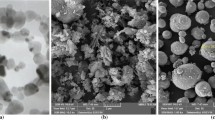Abstract
Electrical discharge-induced ablation machining utilizes the significant chemical energy released by the combustion of oxygen with metals to remove materials, thereby greatly enhancing the material removal rate (MRR). However, in the case of discharge ablation machining of silicon carbide particle-reinforced aluminum matrix composites (SiCp/Al), the effect of oxygen can easily result in the formation of poorly conductive oxides, which in turn affect the machining stability and adversely impact the MRR and quality of the machining surface. To address this problem, this study proposes the use of sodium carbonate (Na2CO3) solution as the atomization medium to chemically dissolve the oxide during processing to achieve the effect of atomized discharge ablation-chemical composite processing. The study found that the Na2CO3 solution facilitated high-temperature chemical etching behavior in the SiCp/Al atomized discharge ablation process. The Na2CO3 solution reacted chemically with and etched away the recalcitrant oxide that formed in the SiCp/Al process area during machining, thereby ensuring efficient and continuous electrical discharge ablation machining. We applied the atomized discharge ablation-chemical composite machining method to mill SiCp/Al. The experimental results showed that the MRR was 2.66 times higher than that of electrical discharge machining (EDM) and 1.98 times higher than that of conventional atomized discharge ablation milling. Moreover, the relative electrode wear ratio was reduced by 76.01% compared with that of EDM and 82.30% compared with that of conventional atomized discharge ablation machining.













Similar content being viewed by others
References
Jebeen MJ, Joseph SS (2016) Investigation on the tensile strength and microhardness of AA6061/TiC composites by stir casting. Trans Indian Inst Met 70(4):1035–1046
Chen JP, Gu L, He GJ (2020) A review on conventional and nonconventional machining of SiC particle-reinforced aluminium matrix composites. Adv Manuf Technol 8(3):279–315
Krishnamurthy L, Sridhara BK, Budan DA (2007) Comparative study on the machinability aspects of aluminium silicon carbide and aluminium graphite composites. Mater Manuf Process 22(7/8):903–908
Huang ST, Zhou L (2010) Evaluation of tool wear when milling SiCp/Al composites. Key Eng Mater 455:226–231
Zhong ZW (2003) Grinding of aluminium-based metal matrix composites reinforced with Al2O3 or SiC particles. Int J Adv Manuf Technol 21(2):79–83
Tosun G, Muratoglu M (2004) The drilling of an Al/SiCp metal-matrix composites. Part I: microstructure. Compos Sci Technol 64(2):299–308
Xiang J, Xie L, Gao F et al (2018) Diamond tools wear in drilling of SiCp/Al matrix composites containing copper. Ceram Int 44(5):5341–5351
Cui Y, Gao S, Wang F et al (2021) Study on the high-speed milling performance of high-volume fraction SiCp/Al composites. Materials 14(15):4143. https://doi.org/10.3390/ma14154143
Ramulu M, Taya M (1989) EDM machinability of SiCp/Al composites. J Mater Sci 24(3):1103–1108
Yang WS, Chen GQ, Wu P et al (2016) Electrical discharge machining of Al2024-65 vol% SiC composites. Acta Metall Sin-Engl 30(5):447–455
Seo YW, Kim D, Ramulu M (2006) Electrical discharge machining of functionally graded 15–35 vol% SiCp/Al composites. Mater Manuf Process 21(5):479–487
Ramulu M, Paul G, Patel J (2001) EDM surface effects on the fatigue strength of a 15 vol% SiCp/Al metal matrix composite material. Compos Struct 54(1):79–86
Zhang Z, Zhang Y, Lin L et al (2021) Study on productivity and aerosol emissions of magnetic field-assisted EDM process of SiCp/Al composite with high volume fractions. J Clean Pr 292:126018. https://doi.org/10.1016/j.jclepro.2021.126018
Gao X, Li J, Xing Q et al (2022) Research on ultrasonic vibration–assisted electrical discharge machining SiCp/Al composite. Int J Adv Manuf Technol 121(3/4):2095–2113
Zhao W, Gu L, Xu H et al (2013) A novel high efficiency electrical erosion process-blasting erosion arc machining. Procedia CIRP 6:621–625
Gu L, Chen JP, Xu H et al (2016) Blasting erosion arc machining of 20 vol.% SiC/Al metal matrix composites. Int J Adv Manuf Technol 87(9/12):2775–2784
Zou Z, Guo Z, Zhang K et al (2022) Electrochemical discharge machining of microchannels in glass using a non-Newtonian fluid electrolyte. J Mater Process Tech 305:117594. https://doi.org/10.1016/j.jmatprotec.2022.117594
Liu JW, Yue TM, Guo ZN (2010) An analysis of the discharge mechanism in electrochemical discharge machining of particulate reinforced metal matrix composites. Int J Mach Tool Manuf 50(1):86–96
Kumar KLS, Sivasubramanian R (2011) Modeling of metal removal rate in machining of aluminum matrix composite using artificial neural network. JCM 45(22):2309–2316
Liu ZD, Yin CJ, Chen LH et al (2014) Efficient combined machining of electrospark-induced controllable combustion and turning dressing for TC4. Mater Manuf Process 29(5):614–620
Cao ZL, Liu ZD, Ling JJ et al (2015) Deep-type hole machining by inner jetted aerosol dielectric ablation. Int J Adv Manuf Technol 78(9/12):1989–1998
Han YX, Liu ZD, Cao ZL et al (2018) Mechanism study of the combined process of electrical discharge machining ablation and electrochemical machining in aerosol dielectric. J Mater Process Technol 254:221–228
Hu WT, Wang HJ, Liu XW et al (2015) Effects of minerals in ferric bauxite on sodium carbonate decomposition and volatilization. J Cent South Univ 22(7):2503–2507
Zhu YX, Yuasa S (1998) Effects of oxygen concentration on combustion of aluminum in oxygen/nitrogen mixture streams. Combust Flame 115(3):327–334
Acknowledgments
The authors acknowledge the financial support provided by the National Natural Science Foundation of China (Grant No. 51975290).
Author information
Authors and Affiliations
Corresponding author
Rights and permissions
Springer Nature or its licensor (e.g. a society or other partner) holds exclusive rights to this article under a publishing agreement with the author(s) or other rightsholder(s); author self-archiving of the accepted manuscript version of this article is solely governed by the terms of such publishing agreement and applicable law.
About this article
Cite this article
Yue, XL., Liu, ZD., Zhou, SC. et al. Study of atomized discharge ablation-chemical composite machining of SiCp/Al. Adv. Manuf. (2024). https://doi.org/10.1007/s40436-023-00480-y
Received:
Revised:
Accepted:
Published:
DOI: https://doi.org/10.1007/s40436-023-00480-y




